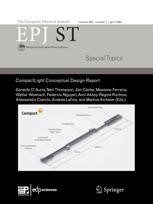Spacecrafts get a boost in ‘Aerogravity Assisted’ interactions
New research examines the effect of rotation and other variables in the applications of ‘aerogravity assisted’ manoeuvres to obtain an energy boost for space craft.
New York | Heidelberg, 17 June 2020
 In a recent paper published in EPJ Special Topics, Jhonathan O. Murcia Piñeros, a post-doctoral researcher at Space Electronics Division, Instituto Nacional de Pesquisas Espaciais, São José dos Campos, Brazil, and his co-authors, map the energy variations of the spacecraft orbits during ‘aerogravity assisted’ (AGA) manoeuvres. A technique in which energy gains are granted to a spacecraft by a close encounter with a planet or other celestial body via that body’s atmosphere and gravity.
In a recent paper published in EPJ Special Topics, Jhonathan O. Murcia Piñeros, a post-doctoral researcher at Space Electronics Division, Instituto Nacional de Pesquisas Espaciais, São José dos Campos, Brazil, and his co-authors, map the energy variations of the spacecraft orbits during ‘aerogravity assisted’ (AGA) manoeuvres. A technique in which energy gains are granted to a spacecraft by a close encounter with a planet or other celestial body via that body’s atmosphere and gravity.
In 2019, Voyager 2 became the second man-made object to leave the solar system, following its counterpart Voyager 1. The energy to carry these probes was obtained via interactions with the solar system’s giant planets – an example of a pure gravity assisted manoeuvre.
The topic approached by the paper is one that has been tackled from a number of different angles before, but the team took the novel approach of considering a passage inside the atmosphere of a planet and the effects of the spacecraft’s rotation as it performs such a manoeuvre. During the course of simulating over 160,000 AGA manoeuvres around the Earth, the team adjusted parameters such as masses, sizes and angular momentum, to see how this would affect the ‘drag’ on the spacecraft, thus changing the amount of energy imparted.
The researchers discovered that the larger the values of the area to mass ratio (A/m – the inverse of area density) that they employed in their models the greater the drag was on the probe, and thus, the greater the energy loss it experienced due to this drag, and the lower its velocity was as a result, but it may increase the energy gains from gravity, due to the larger rotation of the velocity of the spacecraft. The same effect also increased the region in which energy losses occurred whilst simultaneously reducing the area in which maximum velocity can be achieved. Their results indicate that as this is the inverse of area density and density falls off at greater altitudes, drag can be reduced by a trajectory that brings a craft in at higher altitudes. This can eventually approach the values of trajectory given by a pure gravity-assisted AGA.
As the Voyager missions show, when performed at maximum efficiency, AGA manoeuvres have the potential to send mankind beyond the reaches of our solar system into the wider galaxy.
References: Piñeros. J. O. M., Gomes. V. M., dos Santos. W. A., Golebiewska J. Effects of the rotation of a spacecraft in an atmospheric close approach with the Earth. Eur. Phys. J. Spec. Top. 229, 1517–1526 (2020). DOI 10.1140/epjst/e2020-900144-9
This paper is part of the EPJST special issue on "Celestial Mechanics in the XXIst Century"
Further Information
For more information visit: www.epj.org
Services for Journalists
The full-text article is available here.
Contact
Sabine Lehr | Springer | Physics Editorial Department
tel +49-6221-487-8336 | sabine.lehr@springer.com
